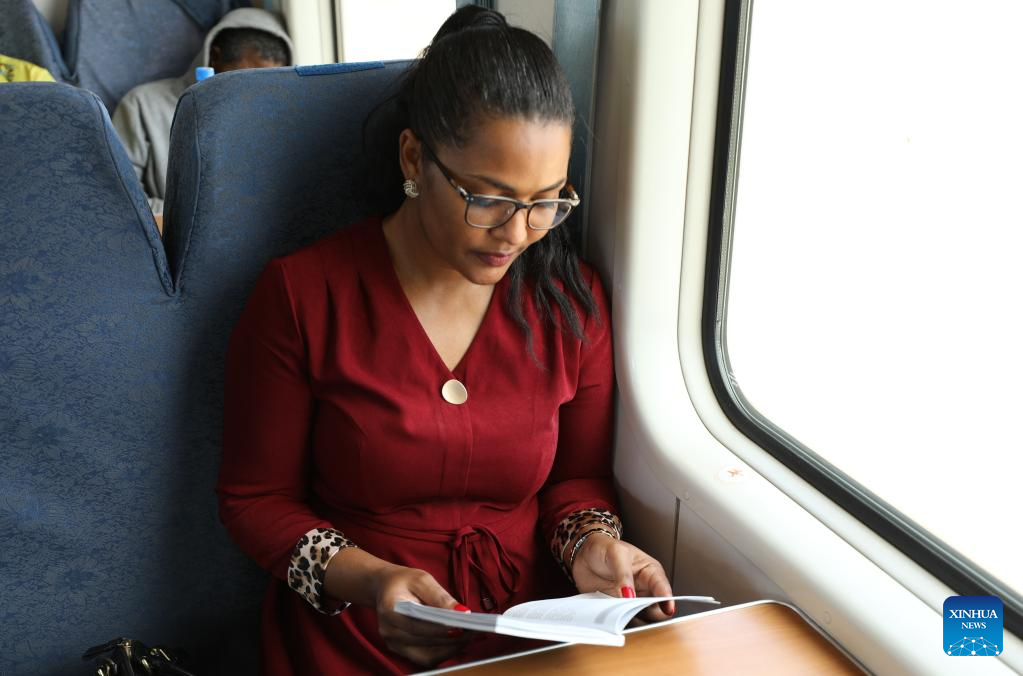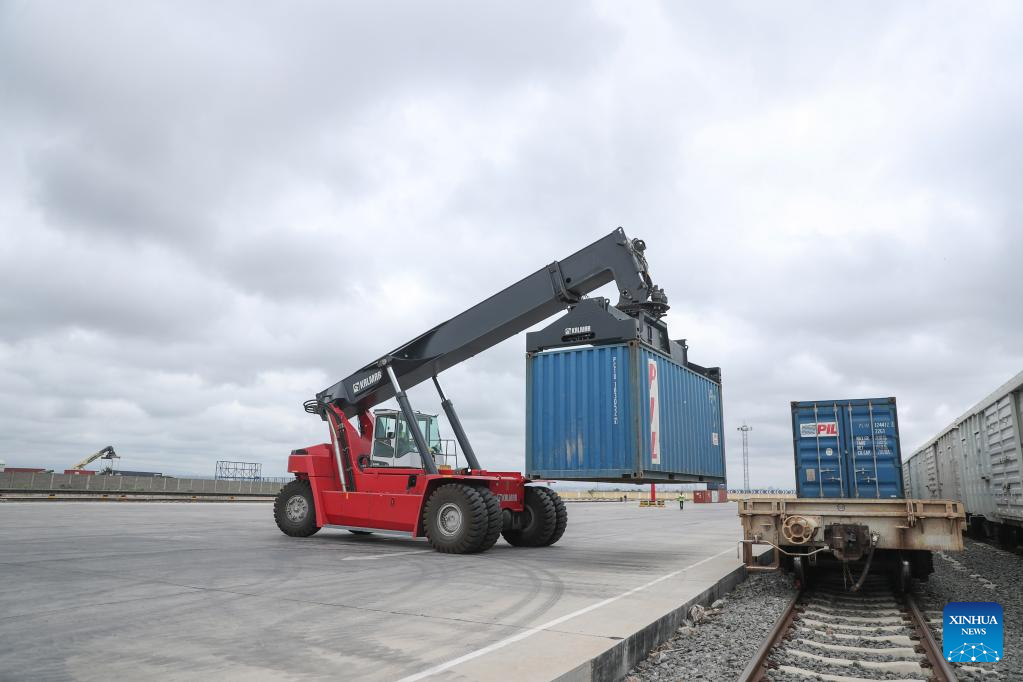
A passenger reads on a train running on the Mombasa-Nairobi Standard Gauge Railway (SGR) in Kenya, May 23, 2022. (Photo by Eric/Xinhua)
by Xinhua writers Bai Lin and Naftali Mwaura
NAIROBI, May 30 (Xinhua) -- Kenya has now found a new lifeline in the Chinese-built Standard Gauge Railway (SGR) since its launch on May 31, 2017.
The Mombasa-Nairobi SGR, mainly financed by China and constructed by China Road and Bridge Corporation (CRBC), which began construction in 2014 and finished in 2017, has become a case study in the transformation of mobility, trade and leisure in Kenya.
EASING MOBILITY
Farahana Mghoi, a Nairobi-based insurance sales executive and a mother of two, has found respite from chaotic road transport thanks to the Mombasa-Nairobi SGR commuter train that she uses every weekend to travel to her hometown of Voi about 328 km southeast of Nairobi, the Kenyan capital, to meet potential clients.
"My experience of using the SGR passenger train since 2018 has been satisfactory. It is very convenient and affordable. I am able to reach my destination on time and negotiate for a business opportunity with ease," Mghoi told Xinhua during a recent interview on the train ahead of the Mombasa-Nairobi SGR's 5th anniversary.
She takes four hours to commute from Nairobi to Voi to meet new clients using the modern train as opposed to seven hours using public service vehicles, locally known as Matatus that are laden with the risk of accident and delay.
Mghoi, who has traveled more than 70 times between Nairobi and Voi using the SGR commuter train, belongs to a growing army of local skilled workforce and tourists, who have embraced it amid the guarantee of seamless mobility.
The Mombasa-Nairobi SGR cut travel time between the two cities by half, from an average of ten hours at the century-old meter-gauge railway to approximately five hours, boosting the movement of cargo and skilled labor along its corridor.
Besides the Mombasa-Nairobi SGR, the Chinese-built SGR project also includes the Nairobi-Suswa SGR that connects Nairobi to Suswa, a small town inhabited by the Maasai people. The 120 km Nairobi-Suswa SGR started operation on Oct. 16, 2019.
Data from Afristar, the SGR operator, show the modern railway has transported more than 7.7 million passengers in the last five years.
In addition, the Mombasa-Nairobi SGR runs six passenger trains daily, says Afristar, adding that in the first five months of 2022, the number of passengers transported through the modern railway reached 962,000, a 63 percent year-on-year increase.
ENHANCING CARGO MOVEMENT
Edward Opiyo, the terminal manager at the Autoports Freight Terminals Limited, a logistics firm, said the launch of the Mombasa-Nairobi SGR freight service in January 2018 ushered in an era of speedy, affordable and safe means of transporting imported cargo from the port of Mombasa to the hinterland.
Currently, it takes eight hours to haul bulk cargo including raw materials for local industries from the port of Mombasa to Nairobi via the modern railway, as opposed to three days using the century-old meter-gauge railway, says Opiyo.
He added that the Mombasa-Nairobi SGR has eased congestion at Mombasa port, and reduced operational costs among local manufacturers besides enhancing the efficiency of local and regional supply chains.
Ernest Ondego, the terminal manager at Grain Bulk Handlers Limited, another Kenyan logistics firm, said that thanks to efficiencies offered by the modern railway, his clients including wheat importers have been able to generate 25 percent savings.
"With the SGR, we have been able to bring losses to zero," said Ondego, adding that importers used to lose up to 100 kg of grains per truckload.
James Siele, business, commercial & operations expert team leader at Kenya Railways Corporation, said one freight train has eliminated the use of 110 trucks for transporting bulk cargo by road from the port of Mombasa to Nairobi, boosting the country's quest for transition to a green and resilient future.
According to Siele, enhanced movement of bulk cargo including raw materials from the port of Mombasa to Nairobi has cut down on operational costs among local manufacturers, leading to reduced prices for essential consumer goods.
Data from Afristar show the modern railway has transported more than 1.7 million TEUs of containers in the last five years.
In addition, the Mombasa-Nairobi SGR runs 16 freight trains daily, says Afristar, adding that the volume of cargo transported by SGR freight train in the last five months stood at 2.54 million metric tons, an 8.3 percent year-on-year increase.
BOOSTING SKILLS TRANSFER
During its five years of safe operation, the modern railway has provided a platform for Kenyan youth to hone their skills, grow their careers and earn a decent income.
In particular, female locomotive drivers like Tabitha Kiplimo, a 30-year-old electrical engineering major, admitted that their lives had been transformed after securing employment with the SGR commuter service.
An internship with China Road and Bridge Corporation soon after graduation paved way for Kiplimo's storied journey from a simple rural girl to a confident locomotive driver.
A two-month course on locomotive operations in China, followed by tutelage by a Chinese instructor soon after the SGR commuter service started operations in June 2017, prepared her adequately for the task of shuttling the train on the modern railway.
Kiplimo is among eight Kenyan female locomotive drivers who have broken the glass ceiling, thanks to training and mentorship provided by their employer, the operator of SGR.
Other beneficiaries of skills transfer that is embedded in SGR localization include John Pius, a 32-year-old mechanical engineering major who in February joined the first cohort of independent Kenyan locomotive drivers.
Pius has been operating the Nairobi-Suswa SGR commuter train independently since February, having acquired adequate skills from a Chinese tutor after he was recruited by CRBC in 2016.
While skills transfer and employment creation have been key features of the SGR operations in Kenya, its positive impact on key economic sectors like agriculture, manufacturing and tourism has been enormous in the last five years.
Siele believed the SGR had a brighter future in Kenya and the East African region since it is expected to enhance connectivity, cross-border trade and free movement of skilled labor, adding that the modern railway has stood out as a beacon of hope in a continent yearning for economic development and social progress. ■

A worker unloads a container from a train in Nairobi freight terminal in Nairobi, Kenya, May 18, 2022. (Xinhua/Long Lei)



